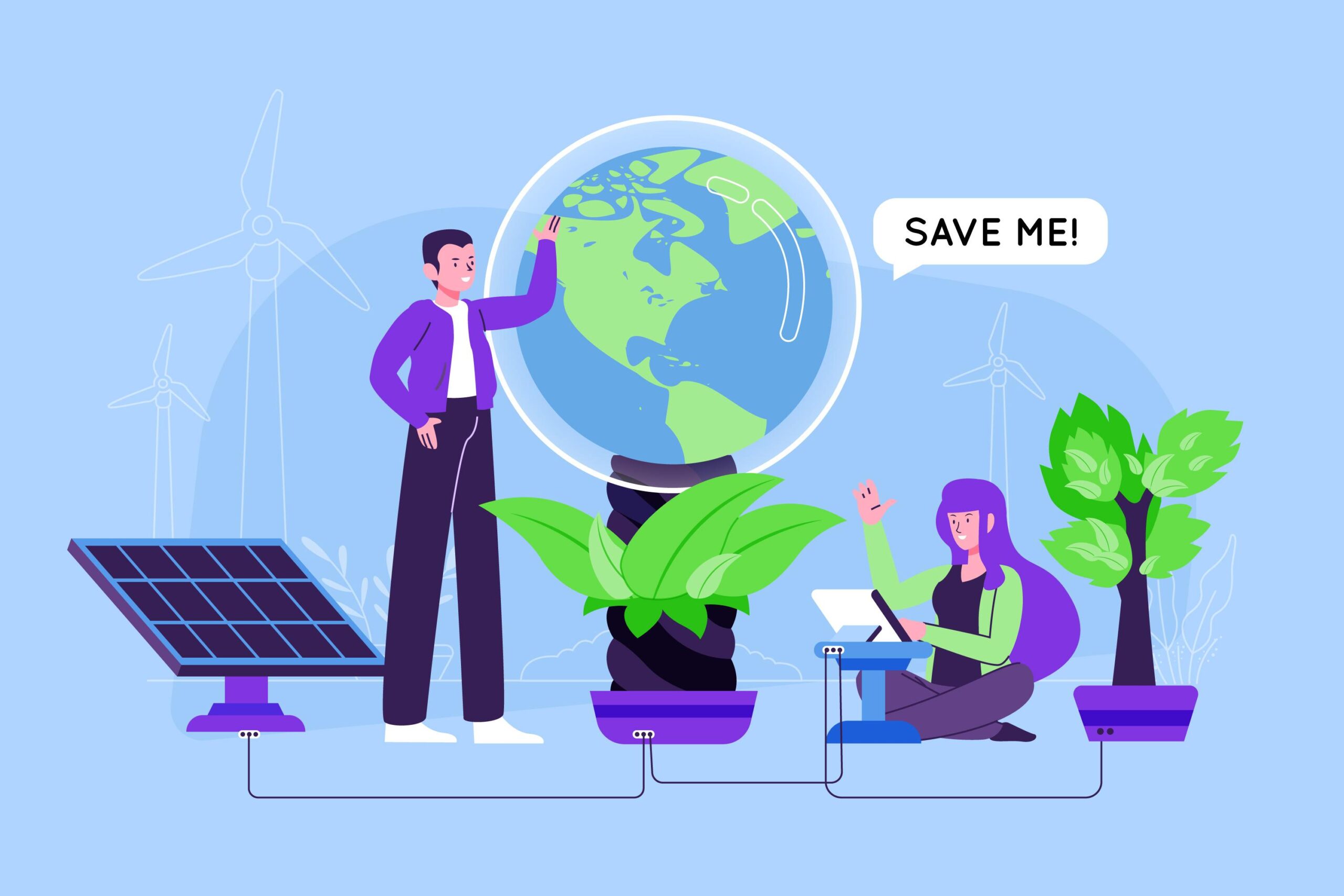Sustainability aims to fulfill current needs while safeguarding the capacity of future generations to satisfy their own requirements. It encompasses the holistic well-being of society, necessitating continual evaluation of the enduring impacts of our decisions.
In today’s contemporary world, characterized by consumerism and predominantly urban lifestyles in both developed and developing nations, we continually deplete vast quantities of natural resources. Statistics suggest that our annual resource consumption exceeds what we can replenish by approximately 40%. Sustainability and the pursuit of sustainable development entail a delicate equilibrium between advancing technologically and economically while safeguarding our environment. Let’s explore several practical approaches through which each of us can contribute to achieving this balance in our daily lives.
Consider Before You Buy: Reducing Excess
“I have enough” serves as the fundamental principle we should embrace. Taking a moment to contemplate before making a purchase often reveals that our impulses, rather than genuine needs, drive many buying decisions. Every item we acquire utilizes resources, leaving an environmental impact in its wake.
Thoughtful purchasing involves questioning the motivation behind each acquisition. If the desire stems from materialistic aspirations, such as status or identification, rather than genuine necessity, it’s crucial to weigh the environmental and resource implications. Now more than ever, we must prioritize conscious consumption, aligning with the ethos of Minimalist Living: “To simplify. To own less. To be free.”
Eliminate Plastic: Embrace a Plastic-Free Lifestyle
Plastic is a persistent pollutant that poses a grave threat to our environment and wildlife. Shockingly, National Geographic reports that a staggering 91% of plastic is not recycled and instead finds its way into landfills, is incinerated, or ends up polluting our natural habitats and oceans. This leads to tragic consequences for marine life, with thousands of seabirds, sea turtles, seals, and other marine mammals perishing each year due to ingestion of plastic or entanglement in it. It’s imperative that we take action to reduce our reliance on plastic. Here are some practical steps we can all take:
- Opt for reusable bags when shopping to cut down on plastic waste.
- Say no to single-use water bottles, not only to minimize environmental impact but also to avoid health hazards associated with ingesting microplastic particles.
- Eliminate plastic cutlery and straws from your daily use. Half of all plastic is single-use or disposable, so carrying your own reusable set when traveling is a simple yet effective way to reduce plastic consumption. Additionally, strive to avoid products made from or packaged in plastic whenever feasible. For instance, choose unwrapped produce at the grocery store, support local businesses, and reduce online shopping, which generates excessive waste.
Food Consumption: A Focus on Reducing Waste
If food waste were a nation, it would rank as the third-largest emitter of greenhouse gases globally, trailing only China and the United States, responsible for emitting 3 billion tons of carbon. According to The Times of India, our country discards food worth Rs 58,000 crore annually, equivalent to 40% of the total production, leading to the tragic loss of 3,000 children daily due to hunger and malnutrition. Furthermore, food waste adversely impacts wildlife and ecosystems.
To address this pressing issue, policies are imperative to standardize date labeling, extend the shelf life of edible food, and facilitate easier donation to those in need. Both businesses and individuals must transition their purchasing habits to minimize the wastage of uneaten food at every stage, from farms and stores to restaurants and households.
Embrace Water Efficiency
The United Nations designates India as a water-stressed region, with a per capita water availability of 1,545 cubic meters. Unchecked discharge of untreated waste and effluents exacerbates water pollution, posing a significant threat to water bodies. Water conservation efforts should prioritize reducing unnecessary consumption and redirecting water flow towards areas where recycling and reuse are feasible.
Given that 70% of water is used for agriculture, embracing efficient techniques like drip irrigation and cultivating crops suited to local climates is crucial. Policy innovations and financial incentives, such as smart subsidies or cash rewards, can motivate farmers to reduce their water footprint measurably. Collaboration among various government departments—Agriculture, Energy, Irrigation, and Rural Development—is essential for devising holistic solutions.
Corporations can adopt Zero Liquid Discharge mechanisms to minimize water discharge into streams and rivers. Individually, conserving water can be achieved through practices like shorter showers, repairing leaky toilets, and opting for low-flow appliances.
Minimize Textile Waste
Many of us delight in fashionable attire without considering the environmental toll of textile production. The intricate supply chains of the textile industry contribute significantly to global greenhouse gas emissions, nearly rivaling those of the entire European Union. Opting for eco-conscious materials like recycled polyester, local or organic cotton, or water-saving fibers such as hemp can reduce this impact. Embracing eco-friendly choices or simply reducing new purchases can help preserve our planet’s resources while valuing what we already own.
Be Mindful of Labels!
Take note of labels across various products, from food to clothing to fashion accessories. While the market may currently offer fewer options, there are clear frontrunners in minimizing your impact on wildlife and the planet.
For example, H&M prioritizes sustainable cotton practices and recycling. Opt for Fair Trade certified goods and support companies committed to sustainable production and fair wages.
Choose organic food whenever feasible, even if it comes with a slightly higher price tag. This choice helps keep harmful pesticides out of our land and water, safeguarding farm workers, wildlife, and your family.
For corporations, it’s crucial to understand that merely being labeled as “Green” won’t suffice. Consumer expectations regarding price point, convenience, durability, and efficiency must be met alongside any sustainability initiatives.
Reducing Business Expenses
Companies should explore transitioning to alternative fuel sources to safeguard their businesses against market fluctuations and reduce reliance on the electricity grid while ensuring a stable supply. Notable companies like Google, IKEA, British Land, and M&S have already committed to this transition.
Incorporating green computing practices is vital. This includes checking product energy efficiency ratings before procurement, optimizing data center usage to lessen cloud clutter, minimizing printing, responsibly disposing of unused computing devices, and utilizing e-waste disposal centers.
The aviation industry stands as a significant contributor to carbon emissions, projected to constitute 25% of global emissions by 2050. Corporates can contribute by avoiding charter planes and promoting alternative transportation options among stakeholders, which may also result in climate-related benefits.
Resource waste is prevalent during corporate events, exhibitions, and conferences, with numerous banners, pamphlets, plastics, notepads, mementos, and bags ending up as waste for marginal brand enhancement. Considerations must be made to minimize such wastage.
The Government’s Function
Our nation is grappling with a staggering amount of waste, producing approximately 62 million tons annually. Urgent measures for waste management are imperative. Looking to successful models abroad, such as Sweden’s innovative approach where recycling plants are kept operational by importing waste from other countries due to a shortage of domestic trash, can serve as inspiration. Sweden’s landfill dumping of household waste is minimal, with over 99% recycled through various methods. Similarly, France’s 2016 Plastic Ban law stands as a proactive measure against plastic pollution globally, aiming to ban all plastic plates, cups, and utensils by 2020.
Moving forward
the principles encapsulated in the 7R’s, depicted in the accompanying image, serve as the foundation for effective waste management. Strict adherence to these principles is imperative to foster ecological equilibrium. However, achieving this goal hinges upon the conscious behavior and concerted efforts of individuals.
- Minimize: The ethos of using less and conserving more should permeate our daily lives. This entails reducing consumption of items such as makeup, toilet paper, printer paper, and other resources wherever possible.
- Maximize: Embracing the philosophy of utilizing items fully is essential. Make the most out of clothing, food, personal energy, and resources to extend their lifespan and minimize waste.
- Prioritize: Time is a precious commodity, and it’s vital to allocate it judiciously to matters of true significance. Eliminate activities and possessions that do not contribute to meaningful outcomes, thereby conserving time, money, energy, and resources for what truly matters.
Now, more than ever, it is pivotal for each individual to recognize their role in sustaining a healthy planet for future generations. Every action, no matter how small, holds significance, and every household’s contribution is indispensable. Remember, your conduct serves as a model for the next generation’s behavior. Therefore, it is incumbent upon us to embrace responsibility for our daily actions. With collective effort and mindful choices, we can swiftly transition towards a sustainable planet.




